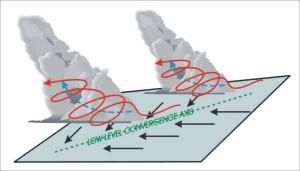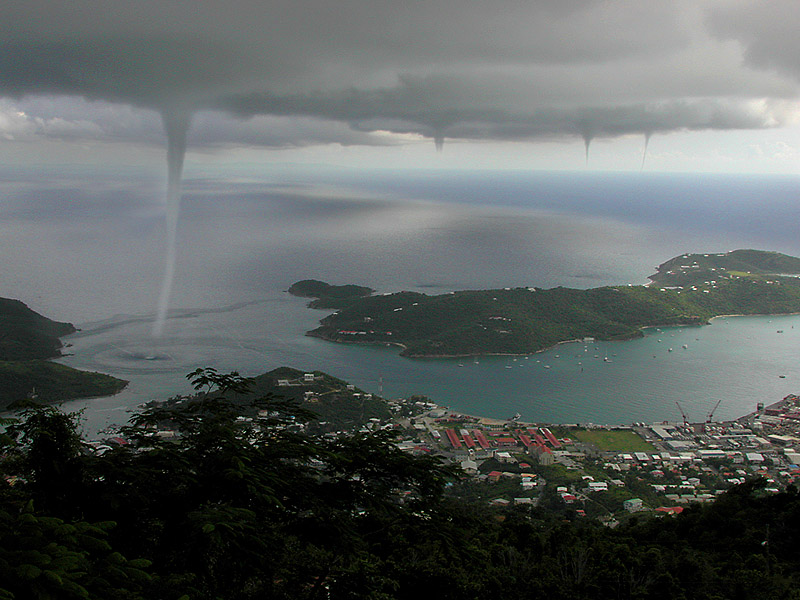Danke Willi für die wichtige Ergänzung. Eine horizontale Windscherung ist natürlich eine der wichtigsten Voraussetzungen für die Entstehung einer Wasserhose nicht superzelligen Ursprungs (analog den Landspouts über Land).

Im Gegensatz zu Tornados über Land erkennt man die ersten Ansätze einer Wasserhose meist am unteren Ende des Wirbels, also direkt auf der Wasseroberfläche. Im Inflow-/Aufwindbereich eines herannahenden Schauers ist es am wahrscheinlichsten, dass sich eine Wasserhose ausbildet, vorausgesetzt es besteht bereits eine Bodenwindkonvergenz. Hier sind die 5 Stadien im Lebenszyklus einer Wasserhose (gemäss Dr. Joseph Golden, Forscher auf dem Gebiet Wasserhosen):
Dark spot: A prominent circular, light-coloured disk first appears on the surface of the water, surrounded by a larger dark area of indeterminate shape and diffuse edges. This light inner circle measures approximately 7.5 to 31 metres (25 to 100 feet) in diameter.
Spiral pattern: Next, a pattern of light- and dark-coloured surface bands spirals out from the dark spot on the water surface. This stage represents the primary growth phase of a waterspout in which the vortex intensifies while simultaneously expanding its radius of influence.
Spray ring: A dense swirling ring (annulus) of sea spray, called a cascade, appears around the dark spot with what appears to be an eye. Stage 3 marks the point at which convergence of inward-flowing angular momentum reaches a critical value in the ring surrounding the dark spot. This accumulation of angular momentum is accompanied by a gradual increase in wind speeds. When the winds attain a speed of 83 km/h (52 mph), a spray ring arises, and the lower portion of the waterspout begins to advance.
Mature vortex: The waterspout, now visibly extending from the water surface toward the overhead cloud mass, achieves maximum organization and intensity. The mature funnel often appears hollow with a surrounding shell of turbulent condensation. The spray vortex may rise to a hundred metres (several hundred feet) or more and often creates a visible wake and associated wave train as it advances. In Stage 4, the rotation and the maximum winds around the centre of the spray vortex peak, and the funnel grows to its maximum diameter and length. Forward motion also reaches its maximum during the latter portions of Stage 4.
Decay: The funnel and spray vortex begin to dissipate when the inflow of warm air into the vortex weakens. The spiral pattern begins to disappear during the end of Stage 4 and by the beginning of Stage 5 is completely gone. The waterspout's forward motion decelerates as well. During Stage 5, the funnel will attain its maximum tilt from the vertical. Finally, when the flow of upward lifted warm air is disrupted by strong sinking motions of rain cooled air, the waterspout integrity starts to collapse. Dissipation occurs abruptly when an advancing shower overtakes the waterspout from the rear.

Gruss Chrigi
- Editiert von Christian Matthys am 04.08.2006, 00:14 -



